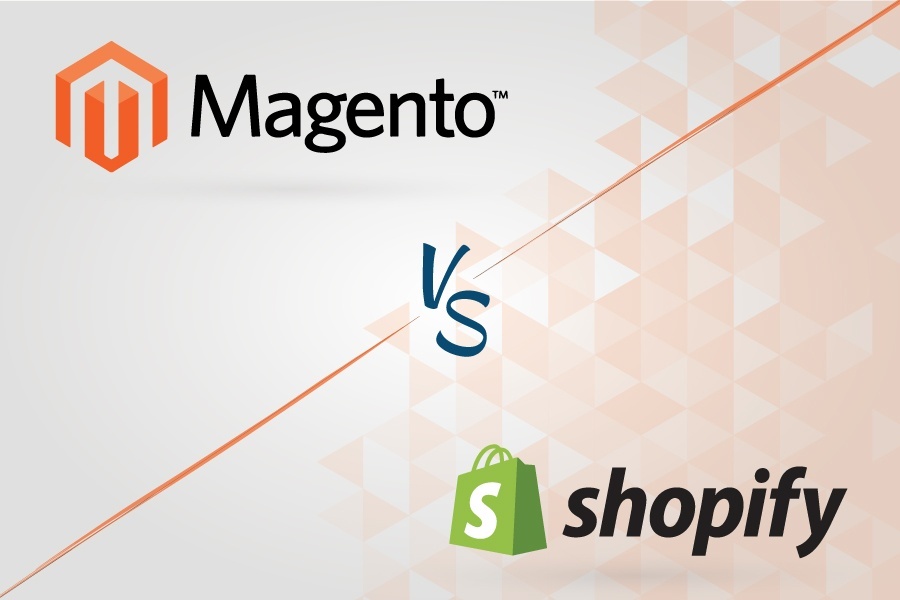We previously discussed our stance on Magento and that we believe it’s the best ecommerce platform for online stores. This blog post is a continuation in a series we are posting detailing why we feel so strongly about it. Check out Part 1 of this series, Magento vs Volusion. Below is Part 2 of why Magento rocks, this time comparing it to Shopify. Watch for more blogs to come for additional parts to this series.
Magento vs. Shopify
With the variety of ecommerce platforms available to run your business online, it’s important to understand the differences and advantages of some of the most recognized platforms currently available. Magento and Shopify are two names readily available, yet many business owners have no idea which of the two are better suited for their kind of business. While Shopify may have a larger, recognizable brand, Magento outperforms that platform in almost every aspect.
Front End
Shopify is a well-known turnkey ecommerce solution, that makes it easy to set up a basic ecommerce site. The key word here is basic. Because Shopify is a fast setup solution, the client ends up trading useful functionality for speed of set up.
To sellers that want to give their store a specific look and feel, this a big problem. Shopify technically offers the ability to fully customize a site, but in reality it’s not that simple. Instead of using an established language like PHP, which has been in use since 1997 for templates and development, Shopify chose to use a language called “Liquid” which has only been used for production since 2006. Because of this choice of language Shopify site owners are forced to pick developers from a small pool of “Shopify experts”. Being forced to select from a small pool of developers negatively effects a Shopify site owner in two ways:
Timing: The smaller the pool of developers, the less availability you are going to have. This can dramatically increase the time it takes to find, hire and complete any work you need done on your website.
Cost: The smaller the pool of developers, the higher the cost for the development. Simple supply and demand.
**Note – Shopify offers support, but not for customizations. This translates to extra costs for support from your “Shopify Expert”
Back End
When it comes to development, the general rule is that the more languages used in the application, the more complicated the application gets.
Shopify demands multiple frontend languages:
• HTML
• CSS
• JavaScript
• Liquid
And multiple backend languages:
• PHP
• Node
• Ruby
• MySQL
• Postgres
• MongoDB
With Magento, almost all of the development is done in PHP with a small amount in HTML and CSS.
For Shopify, needing all of these languages negatively effects the application in two main ways:
cost of development: More languages needed = more developers. It would take multiple sets of developers for Shopify development project.
Productivity: Developers need time to switch from using one language to another – especially with web languages that vary so vastly in their applications (server side vs markup vs client side). Developers coding in multiple languages lose time switching over, and this could lead to extra costs, and extra development time.
With a solution like Magento , since most of the development is in PHP, one only needs one set of developers for both the structure of the site, and development of extensions. This seamless development allows for better integrations, and less development time. With shopify, developers are forced to build apps that interact through a specific layer (http requests) which not only add an extra unnecessary layer to your application, and will likely add extra time to page loads. Think of it like a detour. Instead of taking a direct route to your destination, you are forced to go through
Migration
Shopify, like most turn-key solutions does not offer migration from its platform to another. At most, you can export a csv of your product list. This is potentially very problematic because you are locked in and limited to Shopify’s terms. This means that if Shopify decides to raise the price on their monthly plan, you are forced to pay it, or completely abandon what you have built. With Magento this is not the case. Magento is built on opensource, and widely available technology. It is designed with industry standards, which means you can do things like export a complete database, of not only products, but how those products and their attributes relate to other products.
Pricing
Shopify brings users in with a monthly price, but in actuality there are multiple different fees that a use pays.
Monthly price: This is the advertised price EG. “Set up your site for $29 dollars a month today!”
Percent of your transaction + Credit card transaction fee: Depending on your pricing plan, shopify will take a percentage of each transaction, which equals a percentage of all sales (Unless you use shopify payments. Which limits your choice in card processors).
**Shopify charges extra for functionality that is built in to magento EG. Gift cards.
Verdict
Shopify is not a bad platform for ecommerce. It gets the very basics done, but that’s all. Business owners who are serious about growing their company and taking their online shop into their own hands are likely to benefit more from the superior options and performance of Magento. While allowing for standard online shop controls, Shopify falls behind Magento in terms of pricing, monitoring of stats, hosting and security, and especially user support. For better features at a better price, Magento is the platform serious online business owners should want.


Leave a Reply
You must be logged in to post a comment.